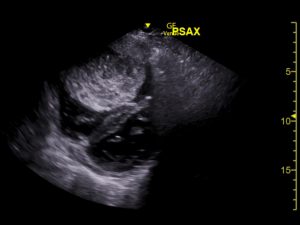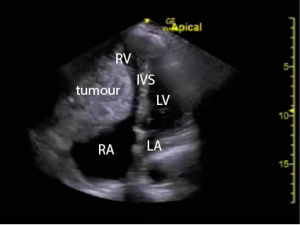
Images Roger Burrell Text Genevieve Carbonatto
A 60 year old man presented to the Emergency Department short of breath having a known right ventricular cardiac tumour with metastases to the lung, liver, spleen and bone. On examination saturating 100% on RA, bilateral pitting pedal oedema, BP, 120/60, HR 68/min.
An ECHO was performed in the Emergency department.
The PLAX shows a large mass in the right ventricle


This is the PSAX showing the large tumour and flattening of the IVS causing a D shaped ventricle


From the PSAX through the aortic valve the large RV tumour is visible causing RVOT obstruction


The 4CV shows the large RV mass, IVS flattening and tumour involvement of the lateral tricuspid valve annulus


The subcostal view shows the tumour indistinctly as there is poor penetration of sound waves in this view


Discussion
- Cardiac tumours are rare
- Metastatic cardiac tumours are 20 – 30 times more common than primary cardiac tumours
- Metastatic tumours are all malignant
- Primary cardiac tumours are more commonly benign than malignant
- Prognosis is in general uniformly poor.
Metastatic cardiac tumours:
- Clinical presentation is dependent on tumour location
- Over 60% involve the pericardium causing effusions or pericarditis
Primary cardiac tumours : benign tumours
- These tumours include papillary fibroelastomas, myxomas , lipomas and cardiac hemangiomas
- Very rare – incidence 0.02%
- Problems arise because of their location as they may interfere with blood flow, valve function, cause arrythmias or embolise either to the lungs (if right sided) or to the brain if left sided.
- Patients are usually asymptomatic until complications arise
- Some tumours (myxomas) are associated with constitutional symptoms such as fever, rash or anorexia
- Tumours can have a solid or papillary appearance. Papillary tumours are more friable and embolise more frequently
Primary cardiac tumours : malignant
- These tumours include undifferentiated pleomorphic sarcomas, angiosarcomas , mesotheliomas and primary cardiac lymphomas
- Patients with angiosarcomas may present with chest pain, SOB, weight loss and malaise. Because of their vascular nature they may also cause cardiac tamponade from catastrophic bleeding
Treatment options for cardiac tumours include resection of the tumour, angio embolisation, chemotherapy and radiotherapy depending on their subtype and their location
References
- Neoplasia and the Heart Pathological Review of Effects With Clinical and Radiological Correlation
Joseph J. Maleszewski, Melanie C. Bois, John P. Bois, Philip M. Young, John M. Stulak and Kyle W. Klarich Journal of the American College of Cardiology
Volume 72, Issue 2, July 2018 DOI: 10.1016/j.jacc.2018.05.026





